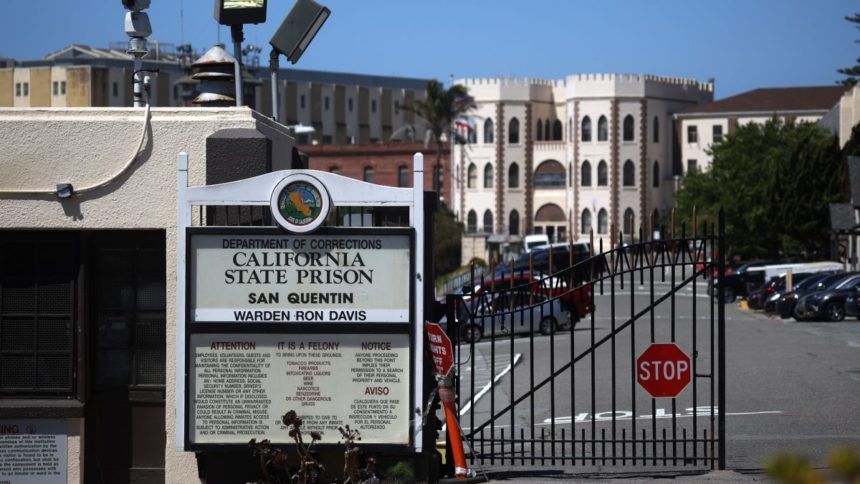Court orders California to cut San Quentin inmates by half

SACRAMENTO, Calif. (AP) A California appeals court has ordered state corrections officials to cut the population of one of the world’s most famous prisons to less than half of its designed capacity, citing officials’ “deliberate indifference” to the plight of inmates during the coronavirus pandemic.
State prison officials said Wednesday that they are deciding whether to appeal the order, which otherwise will force them to parole or transfer about 1,100 inmates serving time in San Quentin State Prison north of San Francisco.
California’s oldest prison, home to its death row, was the site of one of the nation’s worst coronavirus outbreaks, with 28 inmate deaths and 2,200 infections at its peak — about 75% of the inmate population. Nearly 300 employees were sickened and one died, though all but nine employees are now back to work.
It was “the worst epidemiological disaster in California correctional history,” the First District Court of Appeal in San Francisco said in Tuesday’s ruling.
The three-justice court said officials’ decision not to cut the inmate population by half, as recommended by prison officials’ outside advisors in June, was “morally indefensible and constitutionally untenable.”
Assemblyman Marc Levine, a Democrat who represents the area, on Wednesday said that without a further significant reduction in San Quentin’s population, “it is not a question of if another COVID-19 spike will happen at San Quentin, it is a question of when.”
Two federal judges have separately been weighing earlier release orders that would affect the entire California prison system, but they have been constrained by federal law.
However, there is only one current active coronavirus case at San Quentin, and two other California prisons now top it for both active cases and cumulative number of infections.
San Quentin’s outbreak flared when prison officials botched the transfer of inmates from a Southern California prison in May, inadvertently sending infected prisoners who had not been recently tested.
Cases exploded, driven by “the unique architecture and age” of the prison that opened in 1852, and its “exceedingly poor ventilation, extraordinarily close living quarters, and inadequate sanitation,” wrote experts at the University of California, Berkeley School of Public Health and the University of California, San Francisco.
The prison then housed more than 3,500 inmates, many with multiple health vulnerabilities, the experts found. Cutting the population by half would allow many inmates to be housed separately and let officials clear more space to keep inmates spaced for treatment, quarantine or to reduce the virus’ spread, they said.
The three appellate justices said the state failed to present any evidence to the contrary. Their unanimous order requires prison officials to house no more than 1,775 inmates in space designed for about 3,100 inmates and a staffed capacity of nearly 4,500 inmates.
The population can be reduced by transfers to other prisons or paroles, the court said, with a particular emphasis on those inmates over age 60 who have served more than 25 years behind bars.
State prisons now hold fewer than 98,000 inmates, so those from San Quentin could likely be absorbed elsewhere, the court said.
Only about 700 San Quentin inmates could not be considered for release, the court said, because they can never be paroled or are on the nation’s largest death row, though Gov. Gavin Newsom has put a moratorium on executions while he is governor.
State officials “respectfully disagree with the court’s determination,” corrections department spokeswoman Dana Simas said in an email, saying the department “has taken extensive actions to respond to the COVID-19 pandemic.”
The department has released more than 21,000 people since March through earlier releases or because they finished their sentences, “resulting in the lowest prison population in decades,” she said. San Quentin’s population was trimmed to the current roughly 2,900 inmates.
Current inmate coronavirus cases “are the lowest they have been since May,” Simas said, with fewer than 500 current infections and more than 14,000 recovered.
The justices’ sweeping ruling came in lawsuit by a 64-year-old San Quentin inmate Ivan Von Staich, who is serving 17 years-to-life for second-degree murder on top of a 13-year sentence for attempted murder.
He was housed with a 65-year-old inmate in a cell “so small that you can touch the walls with your hands,” where both tested positive for the virus. The court ordered him removed from the prison, noting that he has already been accepted at a residential facility supervised by the state prison system.
Dozens of other San Quentin inmates are separately seeking to be released, with hearings set in Marin County Superior Court.
